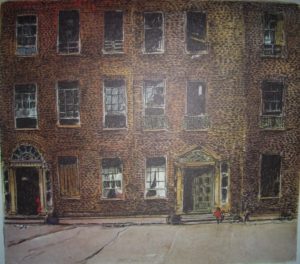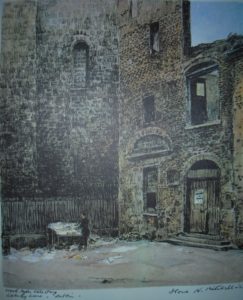Maurice Earls writes: Florina Hippisley Mitchell was born in 1890 in Omaha, Nebraska. It is said that after a Sioux Indian uprising around the turn of the century her father moved the family to Ireland, where he went to work for the Jameson distillery. The last significant Sioux uprising was in 1876 and began when the US government attempted to take over ownership of the Black Hills area following the discovery of gold. These were Sioux and Cheyenne lands and both tribes resisted. The major “Indian” victory, at Little Big Horn, was also known as Custer’s Last Stand. However, the US army eventually prevailed, employing the tactic of attacking the Native Americans’ settlements and encampments. It is possible that some subsequent unrest affected the Mitchell family.


In Dublin Flora Mitchell studied at the Dublin Metropolitan School of Art. In 1930 she married William Jameson, a great-grandson of John Jameson, the founder of the distillery. In her old age, Mitchell produced hundreds of sketches of the streets and buildings of Dublin, many of which are now in the possession of the National Gallery of Ireland. Fifty finished ink and watercolour drawings were used to illustrate her book Vanishing Dublin (1966). The images represent a Dublin in decay, the final days of the old Georgian city.
The 1960s saw a growth rate of around four per cent per annum, which gave rise to a new optimism in a city long depressed. The destruction of much of the old city followed and while many decayed structures were beyond rescuing, many fine buildings ‑ in a mood of enthusiastic modernising ‑ were unnecessarily demolished.


“They say the lion and the lizard keep the courts where Jamshid gloried and drank deep.” But here the prowling cats and soft-spoken pigeons had taken over the Dominick Street of 1965 seen in the drawing. But while the great houses stand blind-eyed, waiting for their end, suddenly in one’s imagination the street is filled with swinging hoops, periwigs, swords, flashing buckles, satins, cascades of lace and great erections of feathers, the shouts of the linkmen and the whine of beggars; all the paraphernalia of social Dublin in the seventeen hundreds, for here was the centre of Dublin’s social life for the first fifty years after it was laid down in 1755. At the start of the nineteenth century the scale of its early magnificence had begun to decline, and the ensuing hundred years brought the great street down to tenement occupation, the noble mantelpieces torn out and sold; the oak staircases burned for firewood; the gilt and plaster ceilings begrimed and rotting; till, at the time of the total demolition of the street, only the dark shells remained to be brought to the ground.
Through a small alleyway alongside the church we pass up Granby Lane and, turning towards the “Black Church” see, on our right hand a small court with the unlikely name of “Paradise Court”. En route we come on a typical scene, wastepaper collecting in the street.


Here a wastepaper collector works at his sorting, within a few yards of a “prie dieu” placed here in memory of Matthew Talbot who died on this spot and whose little shrine is kept perpetually bright with flowers. Matt Talbot is revered in Ireland for the wonderful life of sanctity and deep christianity he led, despite heavy toil, from the age of 25 till his sudden death in 1925. The house in which he lived, off Summerhill, is kept exactly as he left it, as a memorial to his example of goodness and charity and self-imposed penance. It is, sad to say, now under threat of demolition.
But now on into a little square strangely named “Paradise Court”.
An astonishing scene here meets our eyes: a little settlement of whitewashed cottages surrounding a cobbled square, whose centrepiece is a colourful shrine decked with flowers. Lines of washing are strung across from side to side of the court, and a communal mangle lurks somewhat shamefacedly in a corner.
Over all, tower the dark red brick, five-storied, typical town houses of the late eighteenth century, dwarfing the little single storied cottages below. Another little “village” of this kind in Dublin is “Brunswick Villas”, once a coaching stop on the ancient thoroughfare into Dublin. No history can be found of these settlements, but it seems unlikely they could have been built after the early days of the nineteenth century, when city sites became too valuable to be used for single storied cottages such as these.
A little lamp flickers in the shrine at night, and nearby the dark mass of the “Black Church” erected in 1829 now awaits its fate, undecided as yet by the authorities, but possibly to either be demolished or used for secular purposes. The surrounding houses are now pulled down, and the little community of Paradise Court must turn uneasily in their beds at night, dreaming and wondering.
2/5/2019



